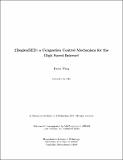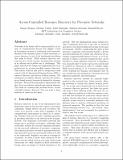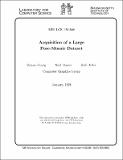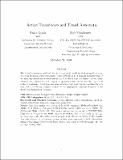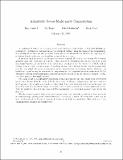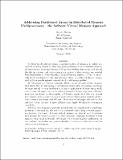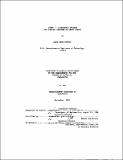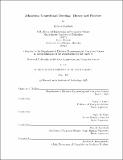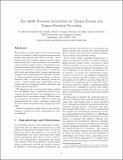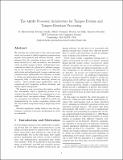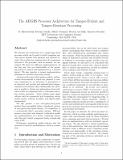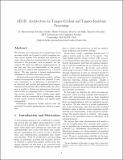Browsing LCS Publications by Title
Now showing items 1-20 of 1163
-
2RegionRED: a Congestion Control Mechanism for the High Speed Internet
(2001-12)This thesis proposes a new Active Queue Management (AQM) scheme called 2RegionRED. It is superior to the classic Random Early Detection (RED) algorithm in that there is an intuitive way to set its parameters and it is ... -
Absenetee Computations in a Multiple-access Computer System
(1968-08)in multiple-access computer systems, emphasis is placed upon serving several interactive users simultaneously. However, many computations do not require user interaction, and user may therefore want to run these computations ... -
An Abstract Architecture for Parallel Graph Reduction
(1984-05)An implementation technique for functional languages that has received recent attention is graph reduction, which offers opportunity for the exploitation of parallelism by multiple processors. While several proposals for ... -
Abstract Data Types in Stack Based Languages
(1978-02)Abstract data types are the basis of an emerging methodology of computer programming. The only existing languages supporting abstract data types directly, CLU and Simula, both require compacting garbage collection, and ... -
An Abstract Implementation for a Generalized Data Flow Language
(1980-01)In this thesis we are concerned with issues arising from the need to achieve concurrency of operation with a computation on a large scale. Several factors contribute toward increasing interest in systems capable of exploiting ... -
An Abstract Model of a Research Institute: Simple Automatic Programming Approach
(1974-03)A problem of knowledge representation is considered in terms of designing a model for a simple sociological structure. A version of the access language is proposed which is based on three kind of expressions accepted by ... -
Abstract Model Specifications for Data Abstractions
(1979-07)A data abstraction introduces a data type with a hidden representation. Specifications of data abstractions are required to allow the data to be described and used without reference to the underlying representation. There ... -
Access-Controlled Resource Discovery for Pervasive Networks
(2002-09)Networks of the future will be characterized by a variety of computational devices that display a level of dynamism not seen in traditional wired networks. Because of the dynamic nature of these networks, resource discovery ... -
Acquisition of a Large Pose-Mosaic Dataset
(1998-01)We describe the generation of a large pose-mosaic dataset: a collection of several thousand digital images, grouped by spatial position into spherical mosaics, each annotated with estimates of the acquiring camera's 6 DOF ... -
Action Transducers and Timed Automata
(1992-11)The timed automaton model of [29, 30] is a general model for timing-based systems. A notion of timed action transducer is here defined as an automata-theoretic way of representing operations on timed automata. It is shown ... -
Actor Systems for Real-time Computation
(1978-03)Actor theory was invented by Hewitt and collaborators as a synthesis of many of the ideas from the high-level languages LISP, GEDANKEN, SMALLTALK, SIMULA-67, and others. Actor theory consists of a group of active objects ... -
Actors and Continuous Functionals
(1978-02)This paper presents precise versions of some "laws" that must be satisfied by computations involving communicating parallel processes. The laws take the form of stating plausible restrictions on the histories of computations ... -
Adaptively Secure Multi-party Computation
(1996-02)A fundamental problem in designing secure multi-party protocols is how to deal with adaptive adversaries (i.e., adversaries that may choose the corrupted parties during the course of the computation), in a setting where ... -
Addressing Partitioned Arrays in Distributed Memory Multiprocessors - the Software Virtual Memory Approach
(1994-12)Harnessing the full performance potential of cache-coherent distributed shared memory multiprocessors without inordinate user effort requires a compilation technology that can automatically manage multiple levels of memory ... -
ADEPT: A Heuristic Program for Proving Theorems of Group Theory
(1966-10)A computer program, named ADEPT (A Distinctly Empirical Prover of Theorems), has been written which proves theorems taken from the abstract theory of groups. Its organization is basically heuristic, incorporating many ... -
Admission Control and Routing: Theory and Practice
(1995-06)Emerging high speed Broadband Integrated Services Digital Networks (B-ISDN) will carry traffic for services such as video-on-demand and video teleconferencing, which require resource reservation along the path on which the ... -
The AEGIS Processor Architecture for Tamper-Evident and Private Tamper-Resistant Processing
(2003-01)We describe the architecture of the AEGIS processor which can be used to build computing systems secure against both physical and software attacks. AEGIS assumes that the operating system and all components external to it, ... -
The AEGIS Processor Architecture for Tamper-Evident and Tamper-Resistant Processing
(2003)We describe the architecture of the AEGIS processor which can be used to build computing systems secure against both physical and software attacks. AEGIS assumes that the operating system and all components external to it, ... -
The AEGIS Processor Architecture for Tamper-Evident and Tamper-Resistant Processing
(2003)We describe the architecture for a single-chip AEGIS processor which can be used to build computing systems secure against both physical and software attacks. Our architecture assumes that all components external to the ... -
AEGIS: Architecture for Tamper-Evident and Tamper-Resistant Processing
(2003)We describe the architecture for a single-chip AEGIS processor which can be used to build computing systems secure against both physical and software attacks. Our architecture assumes that all components external to the ...

